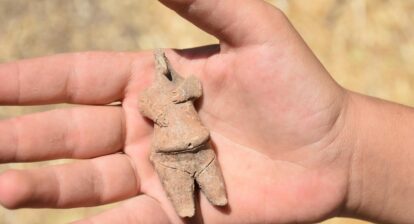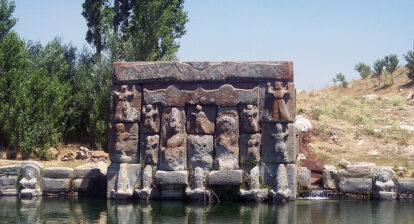A huge paleogenetic study has provided unprecedented insights into the expansion of farming and the development of language from the Caucasus over western Asia and Southern Europe from the early Copper Age until the late middle ages. The analysis has been published simulataneously in three papers in the journal Science, describing the population genetics of Eurasian people from over 10,000 years, which show that farmers did not arise from one population but were a mixture of people from Mesopotaemis (Caucuses), Levant and Anatolia.
The genomes of 727 humans who lived from the Neolithic period (about 10,000 years ago) to the Ottoman period (around 1700 CE), were analysed to reach the conclusions presented in the papers.
Researchers of the first paper investigated the 10,000 years of genomic history in the Southern Arc, a region generally described as westernmost Asia and southeastern Europe and where some of the earliest farming and pottery cultures emerged. The second paper sought to understand how the world’s earliest Neolithic populations formed and presented the first ancient DNA data for Pre-Pottery Neolithic famers from the Tigris side of northern Mesopotamia (eastern Turkey and in northern Iraq). This is a prime region of the origins of agriculture. Meanwhile the third paper reveals the ancestral connections of people from Southern Europe and West Asia since the Bronze age (starting at around 3200 BC).
The following is the original article published here.
The homeland and the spread of Anatolian and Indo-European languages
In the first paper the international team investigated the homeland and the spread of Anatolian and Indo-European languages. The genetic results suggest that the homeland of the Indo-Anatolian language family was in West Asia, with only secondary dispersals of non-Anatolian Indo-Europeans from the Eurasian steppe. At the first stage, around 7,000-5,000 years ago, people with ancestry from the Caucasus moved west into Anatolia and north into the steppe. Some of these people may have spoken ancestral forms of Anatolian and Indo-European Languages.
All spoken Indo-European languages (e.g., Greek, Armenian and Sanskrit) can be traced back to Yamnaya steppe herders, with Caucasus hunter-gatherer and Eastern hunter-gatherer ancestry, who ~5,000 years ago initiated a chain of migrations across Eurasia. Their southern expansions into the Balkans and Greece and east across the Caucasus into Armenia left a trace in the DNA of the Bronze Age people of the region.
As they expanded, descendants of the Yamnaya herders admixed differentially with the local populations. The emergence of Greek, Paleo-Balkan, and Albanian (Indo-European) languages in Southeastern Europe and the Armenian language in West Asia, formed out of Indo-European speaking migrants from the steppe interacting with local people, and can be traced by different forms of genetic evidence. In Southeastern Europe, the Yamnaya impact was profound and people of practically full Yamnaya ancestry came just after the beginning of the Yamnaya migrations.
Some of the most striking results are found in the core region of the Southern Arc, Anatolia, where the large-scale data paints a rich picture of change—and lack of change—over time.
The results show that in contrast to the Balkans and the Caucasus, Anatolia was hardly impacted by the Yamnaya migrations. No link to the steppe can be established for the speakers of Anatolian languages (e.g. Hittite, Luwian) due to the absence of Eastern hunter-gatherer ancestry in Anatolia, contrasting with all other regions where Indo-European languages were spoken.
In contrast to Anatolia’s surprising impermeability to steppe migrations, the southern Caucasus was affected multiple times including prior to the Yamnaya migrations. “I did not expect to find out that the Areni 1 Chalcolithic individuals, who were recovered 15 years ago in the excavation I co-led, would derive ancestry from gene flow from the north to parts of the southern Caucasus more than 1,000 years prior to the expansion of the Yamnaya, and that this northern influence would disappear in the region before reappearing a couple of millennia later. This shows that there is a lot more to be discovered through new excavations and fieldwork in the eastern parts of Western Asia”, says Ron Pinhasi.
“Anatolia was home to diverse populations descended from both local hunter-gatherers and eastern populations of the Caucasus, Mesopotamia, and the Levant”, says Songül Alpaslan-Roodenberg. “The people of the Marmara region and of Southeastern Anatolia, of the Black Sea, and the Aegean region all had variations of the same kinds of ancestry”, continues Alpaslan-Roodenberg.

Westward and northward migrations out of the West Asian highlands split the Proto-Indo-Anatolian language into Anatolian and Indo-European branches. Yamnaya pastoralists, formed on the steppe by a fusion of newcomers and locals, admixed again as they expanded far and wide, splitting the Proto-Indo-European language into its daughter languages across Eurasia. Border colors represent the ancestry and locations of five source populations before the migrations (arrows) and mixture (pie charts) documented here. (Lazaridis et al Science 2022)
First farming societies and their interactions
The second paper seeks to understand how the world’s earliest Neolithic populations (~12,000 years ago) were formed. “The genetic results lend support to a scenario of a web of pan-regional contacts between early farming communities. They also provide new evidence that the Neolithic transition was a complex process that did not occur just in one core region, but across Anatolia and the Near East”, says Ron Pinhasi.
It presents the first ancient DNA data for Pre-Pottery Neolithic farmers from the Tigris side of northern Mesopotamia—both in eastern Turkey and in northern Iraq — a prime region of the origins of agriculture. It also presents the first ancient DNA from Pre-Pottery farmers from the island of Cyprus, which witnessed the earliest maritime expansion of farmers from the eastern Mediterranean. It furthermore provides new data for early Neolithic farmers from the Northwest Zagros, along with the first data from Neolithic Armenia. By filling these gaps, the authors could study the genetic history of these societies for which archaeological research documented complex economic and cultural interactions but could not trace mating systems and interactions which do not leave visible material traces. Results reveal admixture of pre-Neolithic sources related to Anatolian, Caucasus, and Levantine hunter-gatherers, and shows that these early farming cultures formed a continuum of ancestry mirroring the geography of West Asia. The results also chart at least two pulses of migration from the Fertile Crescent heartland to the early farmers of Anatolia.
The Historic Period
The third paper reveals how polities of the ancient Mediterranean world preserved contrasts of ancestry since the Bronze Age but were linked by migration. The results show that the ancestry of people who lived around Rome in the Imperial period was almost identical to that of Roman/Byzantine individuals from Anatolia in both their mean and pattern of variation, while Italians prior to the Imperial period had a very different distribution. This suggests that the Roman Empire in both its shorter-lived western part and the longer-lasting eastern part centered on Anatolia had a diverse but similar population plausibly drawn to a substantial extent from Anatolian pre-Imperial sources.
“These results are really surprising as in a Science paper that I co-led in 2019, on the genetic ancestry of individuals from Ancient Rome, we found a cosmopolitan pattern that we thought was unique to Rome. Now we see other regions of the Roman Empire were also just as cosmopolitan as Rome itself”, says Ron Pinhasi.
More information can be found here
Original studies:
- The genetic history of the Southern Arc: a bridge between West Asia and Europe
- Ancient DNA from Mesopotamia suggests distinct Pre-Pottery and Pottery Neolithic migrations into Anatolia
- A genetic probe into the ancient and medieval history of Southern Europe and West Asia







